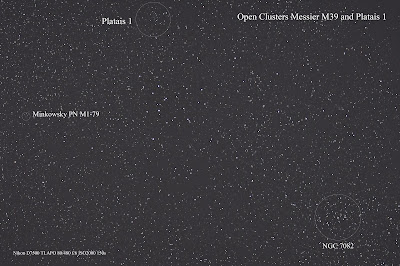July 2018 was a very warm and very dry month. Two days of rain with only 3 l/m2 and an average temperature above 20°C.
Pascal Hilkens Astro Home Page
Thursday, August 2, 2018
Tuesday, July 31, 2018
Flattener correcting the view field - Importance of working distance.
 |
| Flattener at a distance of 10mm from sensor showing clearly aberration at the edges. |
According to the technical data the ideal working distance to the sensor is depended of the focal length of the refractor :
♦ focal length < 450 mm: 128 mm
♦ focal length 450-490 mm: 123 mm
♦ focal length 500-550 mm: 118 mm
♦ focal length 560-590 mm: 116 mm
♦ focal length 600-690 mm: 113 mm
♦ focal length 700-800 mm: 111 mm
♦ focal length ab 800 mm: 108 mm
An underrun or an overrun of the distance of up to 5% has no visible effect on the sharpness in the field of sensors with formats up to APS-C. With larger sensors, the tolerance is reduced to 1-2%.
 |
| Flattener 100mm - Picture is sharp at the edges |
Monday, July 30, 2018
M39, NGC7082, Minkowsky M1-79, Platais 1
Looking into more details around Messier M39, I found beside Platais 1, also NGC7082 and the Planetary Nebula Minkowsky M1-79 of Magnitude 13.9.
Open Cluster M39 and Platais 1
In constellation Cygnus the open cluster M39 and the faint open cluster Platais 1 can be observed. The pictures are taken with Nikon D7500 and refractor TLAPO 80/480 f/6, each picture ISO2000 and 30s exposed. Stacking using deepskystacker and limited editing with CS4.
Globular Cluster Messier M2
Globular Cluster Messier M2 is the most compact cluster in the Messier group. It's located in the constellation Aquarius at a distance of 40.000 lightyears from Earth. The cluster counts more then 1.500.000 stars.
The pictures are taken with Nikon D7500 and refractor TLAPO 80/480 f/6, each ISO800 and 30s. The moon was 83% impacting brightness of the picture. Stacking with deepskystacker and limited editing using CS4.
The pictures are taken with Nikon D7500 and refractor TLAPO 80/480 f/6, each ISO800 and 30s. The moon was 83% impacting brightness of the picture. Stacking with deepskystacker and limited editing using CS4.
Sunday, July 29, 2018
Messier M17 Swan Nebula
Messier M17, also known as the Swan Nebula or The Omega Nebula is an emission Nebula located about 6000 light years from Earth. It is an action star forming region, the same as M42. M17 can be observerd in the constellation Sagittarius and is part of the Sagitarrius spiral arm of our own galaxy.
The pictures shows the Swan easily. The picture is the result of 18 exposures, stacked using Deepskystacker and editing using CS4.
The pictures shows the Swan easily. The picture is the result of 18 exposures, stacked using Deepskystacker and editing using CS4.
Saturday, July 28, 2018
Helios - ASH Polaris BBQ
Daarna werd het iets stiller want de bewolking zorgde ervoor dat de maansverduistering onzichtbaar bleef. Even was er een opflikkering waarbij de rode maan zich bloot gaf, maar het was maar tijdelijk. Dus hadden we voldoende tijd om wat bij te praten en de overgangen van Iridium flares en ISS te observeren.
Subscribe to:
Comments (Atom)







